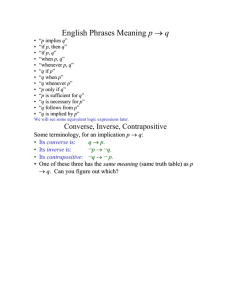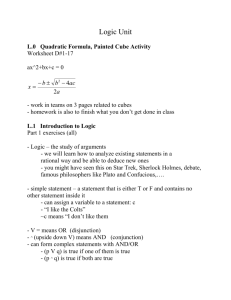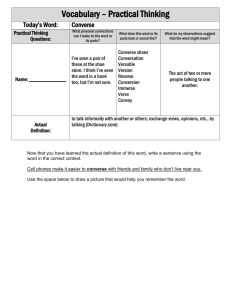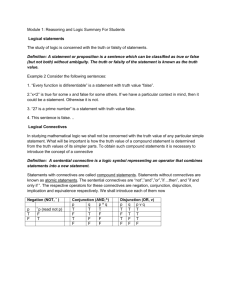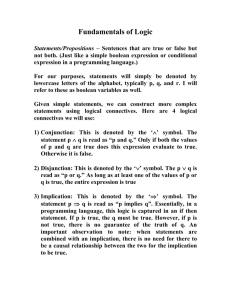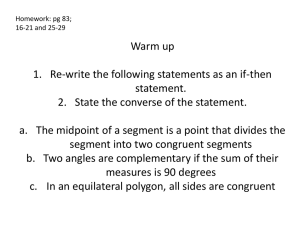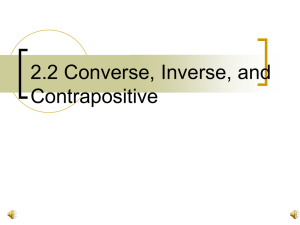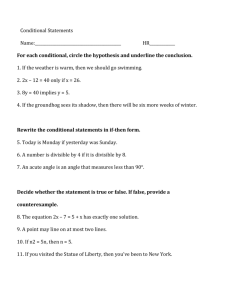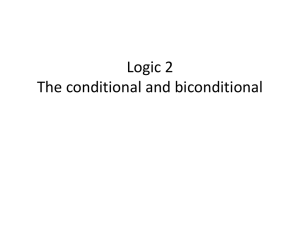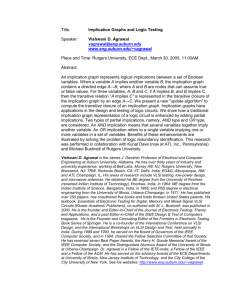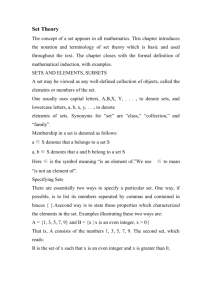Sets and Mathematical Notation
advertisement
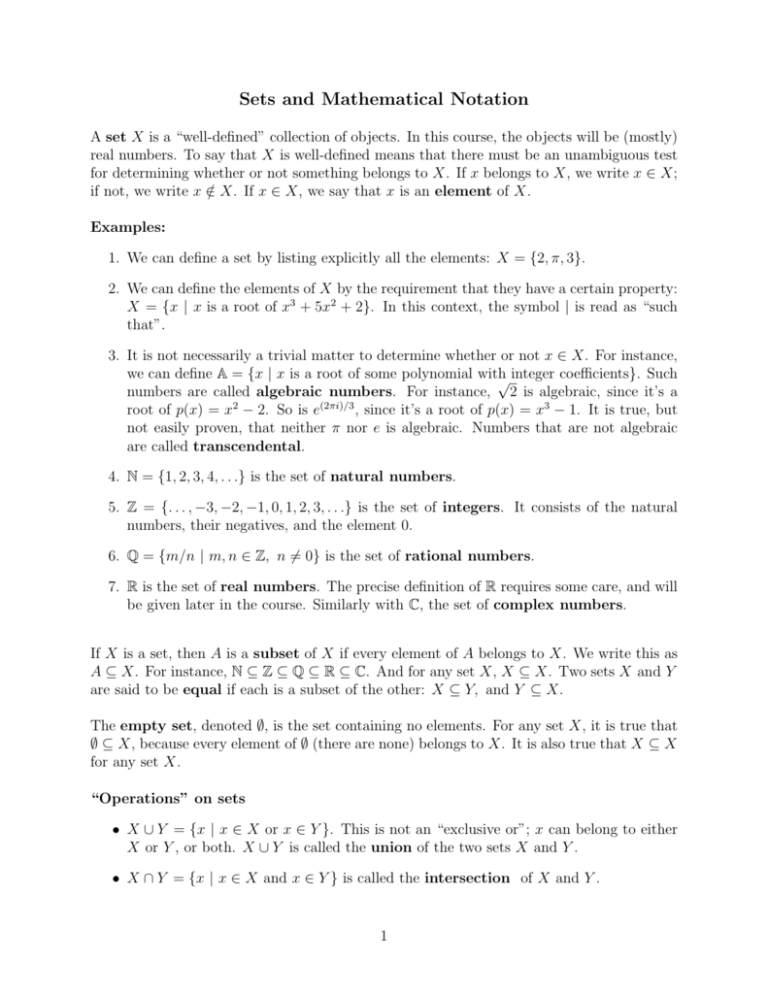
Sets and Mathematical Notation
A set X is a “well-defined” collection of objects. In this course, the objects will be (mostly)
real numbers. To say that X is well-defined means that there must be an unambiguous test
for determining whether or not something belongs to X. If x belongs to X, we write x ∈ X;
if not, we write x ∈
/ X. If x ∈ X, we say that x is an element of X.
Examples:
1. We can define a set by listing explicitly all the elements: X = {2, π, 3}.
2. We can define the elements of X by the requirement that they have a certain property:
X = {x | x is a root of x3 + 5x2 + 2}. In this context, the symbol | is read as “such
that”.
3. It is not necessarily a trivial matter to determine whether or not x ∈ X. For instance,
we can define A = {x | x is a root of some polynomial with
√ integer coefficients}. Such
numbers are called algebraic numbers. For instance, 2 is algebraic, since it’s a
root of p(x) = x2 − 2. So is e(2πi)/3 , since it’s a root of p(x) = x3 − 1. It is true, but
not easily proven, that neither π nor e is algebraic. Numbers that are not algebraic
are called transcendental.
4. N = {1, 2, 3, 4, . . .} is the set of natural numbers.
5. Z = {. . . , −3, −2, −1, 0, 1, 2, 3, . . .} is the set of integers. It consists of the natural
numbers, their negatives, and the element 0.
6. Q = {m/n | m, n ∈ Z, n 6= 0} is the set of rational numbers.
7. R is the set of real numbers. The precise definition of R requires some care, and will
be given later in the course. Similarly with C, the set of complex numbers.
If X is a set, then A is a subset of X if every element of A belongs to X. We write this as
A ⊆ X. For instance, N ⊆ Z ⊆ Q ⊆ R ⊆ C. And for any set X, X ⊆ X. Two sets X and Y
are said to be equal if each is a subset of the other: X ⊆ Y, and Y ⊆ X.
The empty set, denoted ∅, is the set containing no elements. For any set X, it is true that
∅ ⊆ X, because every element of ∅ (there are none) belongs to X. It is also true that X ⊆ X
for any set X.
“Operations” on sets
• X ∪ Y = {x | x ∈ X or x ∈ Y }. This is not an “exclusive or”; x can belong to either
X or Y , or both. X ∪ Y is called the union of the two sets X and Y .
• X ∩ Y = {x | x ∈ X and x ∈ Y } is called the intersection of X and Y .
1
• ∼ X = {x | x ∈
/ X} is called the complement of X. Here X is assumed to be a
subset of some known set like the real numbers.
• X \ A = {x | x ∈ X and x ∈
/ A} is called the complement of A in X. For instance,
R \ Q is the set of irrational numbers.
• If X and Y are two sets, their Cartesian product, denoted X × Y is defined by
X × Y = {(x, y) | x ∈ X, and y ∈ Y }.
That is, the Cartesian product of X and Y is the set of all ordered pairs, the first
element of which belongs to X and the second to Y . If X = Y , then we write X × X
as X 2 . For instance, the plane R2 is the same as R × R. Similarly, X n = X × · · · × X
(n times).
Quantifiers
• The symbol ∀ is read “for all”. Equivalently, “for every”, “for any” and “for each”.
For instance
A ⊆ X means ∀x ∈ A, x ∈ X.
• The symbol ∃ is read “there exists”. Equivalently, “for some”, “there is”, or “one can
find”. For instance,
A is not a subset of X if ∃x ∈ A \ X. (A \ X 6= ∅)
Implications
A proposition (also, depending on the context, called a theorem, lemma, or corollary) is a
(grammatically correct) sentence of the form “if A, then B”. This is written A ⇒ B, and is
read as “A implies B”. That is, if A is true, then B must be true. A is said to be “sufficient”
for B, and B is “necessary” for A. Propositions are also called implications. A well-formed
proposition is either true or false, and formal mathematics can be said to consist of the
proof or disproof of mathematical propositions. (Actually, there is a lot of tricky business
involved with set theory, and it’s a famous theorem of Godel that there exist well-formed
statements whose truth or falsity cannot be determined. But we’ll ignore this minor issue,
since it doesn’t arise here.)
To prove the implication A ⇒ B, you assume that A is true, and then attempt to show
that B is also true. To disprove it, you must find an example for which A holds, but B
does not.
Examples:
1. 0 < x < 1 ⇒ x2 < x. Here, A is the statement “Suppose x is any real number in
(0, 1).”, and ⇒ is read “then”, while B is the statement “x2 < x.” Proof: Assume that
x is a real number in (0, 1). Then, since x > 0, multiplying both sides of an inequality
by x doesn’t reverse the inequality. Since x < 1, we have x · x = x2 < x · 1 = x.
2
2. The converse of A ⇒ B is the implication B ⇒ A. The converse of A ⇒ B may be
either true or false, regardless of the truth or falsity of A ⇒ B. The converse of the
implication above is the implication x2 < x ⇒ 0 < x < 1. In this case, the converse is
true. Here is an example where the converse is false: x2 = 5 ⇒ x ∈
/ Q.
3. The contrapositive of the implication A ⇒ B is the implication ¬B ⇒ ¬A, where
the symbol ¬ is read as “not”. The contrapositive is logically equivalent to the original
implication. For instance, “If Amy is human then Amy is a mammal.” The contrapositive is “If Amy is not a mammal, then Amy is not human”. We often use the
contrapositive implication to prove something - this is called a “proof by contradiction”. The contrapositive of (1) is the statement x2 ≥ x ⇒ x ∈
/ (0, 1). Proof: Suppose
2
2
that x ≥ x. If x ∈ (0, 1), then we can show (above) x < x. Therefore, x ∈
/ (0, 1).
Double implications
An implication of the form A ⇐⇒ B is really two implications, A ⇒ B, and B ⇒ A. That
is, both A ⇒ B and its converse are true. Both must be proven to establish the truth of this
statement. In English, we read A ⇐⇒ B as “A implies and is implied by B”, or “A is true
if and only if (iff) B is true” or (as our forefathers might say, “A is necessary and sufficient
for B”).
Definitions should be read as double implications: for instance
A ⊆ B ⇐⇒ ∀x ∈ A, x ∈ B.
That is, if A ⊆ B, then any element of A belongs to B. And conversely, if any element of
A belongs to B then A ⊆ B. If you’re given that A ⊆ B, you know that any element of
A belongs to B. On the other hand, if A and B are two sets and you can show that any
element of A belongs to B, then you’ve proven that A ⊆ B.
Another implied double implication is involved in proving the equality of two sets. For
example, to show
A ∩ (B ∪ C) = (A ∩ B) ∪ (A ∩ C),
you must show that A ∩ (B ∪ C) ⊆ (A ∩ B) ∪ (A ∩ C) and conversely. To do this, you start by
assuming that x ∈ A ∩ (B ∪ C) and show that x ∈ (A ∩ B) ∪ (A ∩ C). Then do the converse.
Negations
Negations can be a bit tricky. Obviously, we replace “is” by “is not”. We also replace ∃ with
∀ and vice versa. For example, the contrapositive of the implication
∀x ∈ A, x ∈ B ⇒ A ⊆ B
is the statement
¬(A ⊆ B) ⇒ ¬(∀x ∈ A, x ∈ B), or
3
A is not a subset of B ⇒ ∃x ∈ A | x ∈
/ B.
In English, the right hand side of the implication reads “for some x ∈ A, x is not in B”.
4
